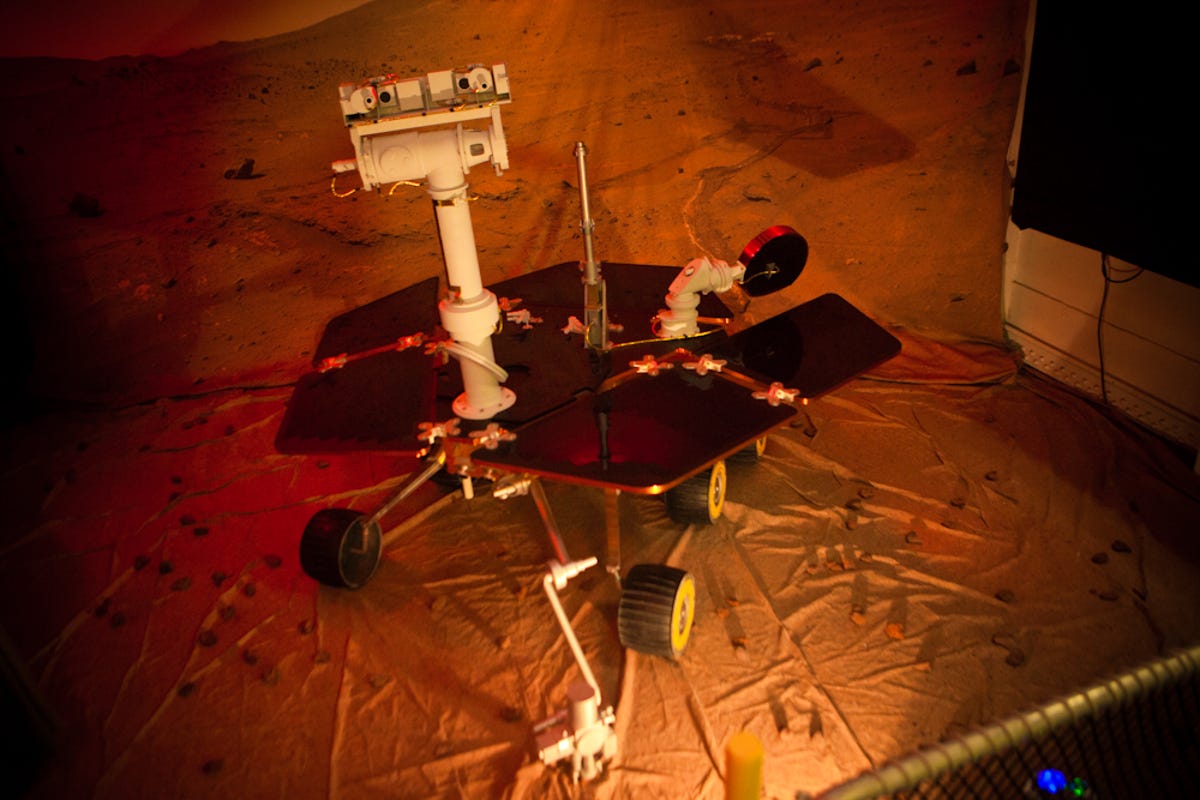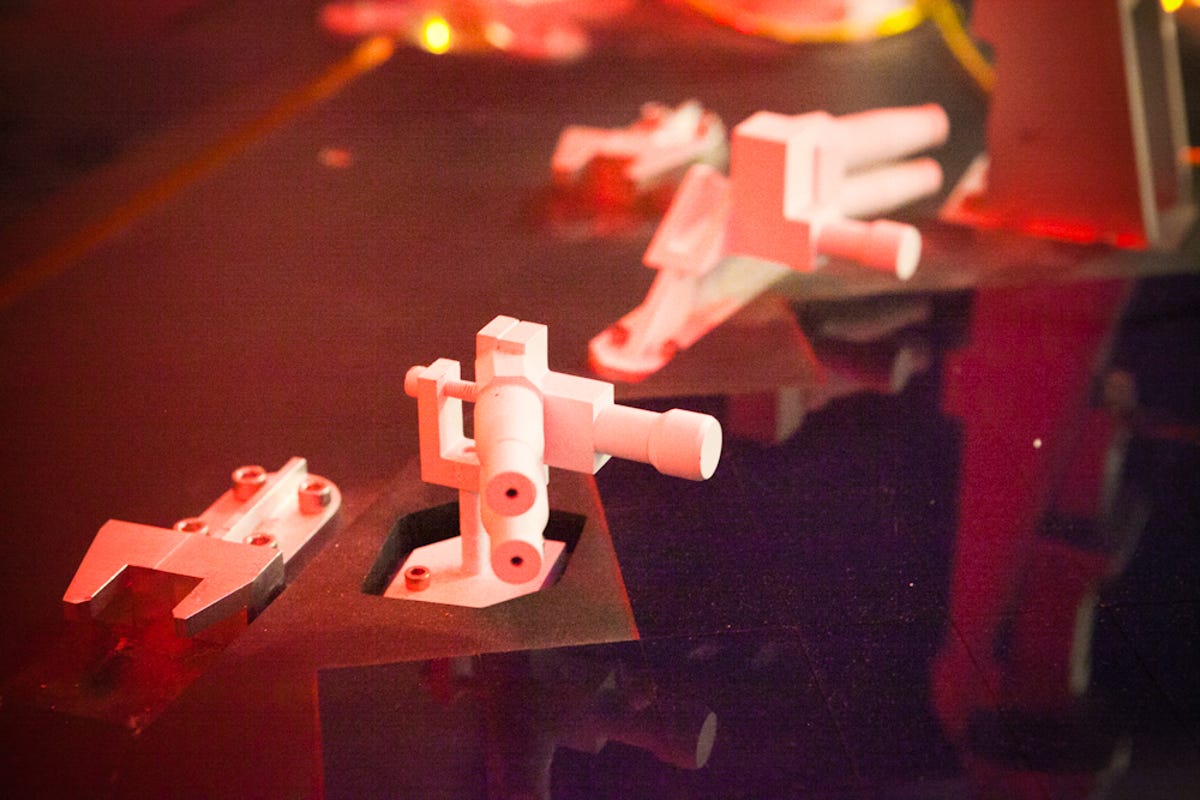NASA exhibits scale model of Mars rover (photos)
NASA and Jet Propulsion Labs are showing off a scale replica of the Mars rover Opportunity, while its real-life counterpart actively explores the Red Planet.

NASA and JPL
ALAMEDA, Calif.--People who've been following the adventures of NASA's two Mars rovers can now get an up-close look at one of the wheeled laboratories without traveling 36 million miles to get there.
NASA and its Jet Propulsion Labs recently opened an exhibit featuring a scale model of the Mars Exploration Rover Opportunity, giving Bay Area visitors a rare view of the wide array of instruments the rover totes along while exploring the Red Planet.
Along with its companion, Spirit, the real Opportunity rover embarked in 2003 on a one-way mission to analyze Martian terrain with an array of high-tech instruments.
Its earthbound counterpart is equipped with replicas of all the tools and instruments aboard the actual 7.5-foot-wide and 5-foot-long robotic science lab. Here, the Opportunity model resembles a vehicle with a bit of a human personality, with its arm and eye-like cameras mounted on an upright head.
The location of the project is not without significance. The replica is on display aboard the USS Hornet, a ship that itself became part of space history when it recovered capsules from the Apollo 11 and 12 Moon missions.
Instrument Deployment Device
Mounted at the end of the arm are four analysis tools that get up close with the Martian terrain. The Microscopic Imager is a microscope and camera that can identify the size and shape of grains in sedimentary rocks, helpful in the search for evidence of water.
Along with the Mossbauer Spectrometer, which analyzes the iron in rocks and soil; the Alpha Particle X-ray Spectrometer, which analyzes the elemental composition; and the Rock Abrasion Tool, a tool used to grind down rock samples to expose fresh material, the IDD is NASA scientists' direct line to the Martian soil.

Sample analysis at Mars
The stereo cameras
Eyes to the world
The 45-degree wide angle, black-and-white stereo pair navigation camera, which makes up the inner set of "eyes," is sort of a scout camera.
Opportunity's operators back on Earth use the navigation camera to plan movements of the rover, and make decisions about where to travel and what features to head toward to examine up close.
The outer "eyes" of the head are the full-color panorama camera, which provides stunning, detailed views of the terrain.
With 14 different types of filters at its disposal, the panorama camera gives not only realistic views, but is also capable of a spectral analysis of minerals and the atmosphere. NASA calls it the best camera ever sent to the surface of another planet.
Another day on Mars
This mosaic of images, taken with the navigation camera aboard the actual Opportunity rover, shows its windblown sand and bedrock surroundings on September 16, which was the 2,363rd Martian day, or sol, of Opportunity's mission.
This is just a portion of a 360-degree panoramic view that was created from many component images. (See the full-size, zoomable image here.) For scale, NASA says the distance between the parallel wheel tracks in the right half of the image is about 40 inches.
Close-up of wheel
Each wheel has an independent motor, and the two front and two rear wheels are independently steerable, making the rover very maneuverable. Although the vehicle's top speed is 5cm per second, the vehicle is normally operated at about 1cm per second out of caution.
A combination of a wide wheel base and small wheels is not ideal, according to NASA, and larger wheels would have given the rovers more stability and better agility for moving over obstacles. However, space constraints meant NASA kept the wheels as small as possible.
Indeed, the next rover to visit Mars, called Curiosity, will have bigger wheels than both Spirit and Opportunity.
Although they operated well past their initial three-month mission assignment, failure in Spirit's right-front wheel ultimately left it stranded, immobile in the soft soils of Mars.
High Gain Antanea
UHF radio band
By using the UHF radio band, which has transmitted 95 percent of Opportunity's communications, the rover can transmit more data using less energy, a valuable resource to the isolated robot.
Calibration target
This 3-inch sundial-like monolith mounted on the rover deck is the "pancam" calibration target, a simple tool to adjust the images received from Opportunity's cameras.
Colored blocks allow for color calibration, and shadows cast by the center post allow scientists to properly adjust the brightness and contrast of each panorama camera image.
All alone on Mars for years
Two rechargeable batteries store energy for use when the panels are not receiving sunlight.
Incredibly, the rover needs just about 100 watts to power its movement. Daily basic survival and communications require about 180 watt-hours per day.
Accumulation of Martian dust on the panels proved to put a significant dent in the amount of energy the panels could absorb--a problem that was solved naturally when Martian winds and dust devils cleared the panels, giving the rover more energy to move and conduct experiments.

